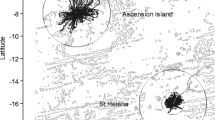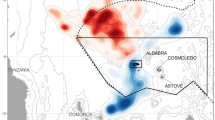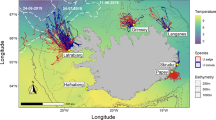This bird's bizarre physique and sparse hunting grounds account for its languid lifestyle.
Abstract
Aspects of the morphology and life history of frigatebirds verge on the extreme, and how they spend their time at sea has been a mystery until now1,2,3. Here we use data collected by altimeters and satellite transmitters attached to individual frigatebirds to show that these birds are continuously on the wing, day and night — they fly in a succession of climbs and descents, soaring in circles on thermals to heights of up to 2,500 m and gliding down in the direction of travel. The birds' curious morphology and flight patterns result in extremely low costs of foraging, but they also cause them to travel slowly over large distances, putting frigatebirds at an evolutionary extreme that enables them to exploit tropical waters in which prey is scarce.

O. CHASTEL

Similar content being viewed by others
References
Diamond, A. W. Condor 75, 200–209 (1973).
Nelson, B. N. Living Birds 14, 113–155 (1976).
Pennycuick, C. J. J. Exp. Biol. 102, 307–325 (1983).
Orta, J. in Handbook of the Birds of the World Vol. 1 (eds del Hoyo, J., Elliott, A. & Sargatal, J.) 362–376 (Lynx, Barcelona, 1992).
Alerstam, T. Bird Migration (Cambridge Univ. Press, Cambridge, 1990).
Augstein, E. Meteorology over the Tropical Oceans (ed. Shaw, D. B.) (R. Meteorol. Soc., Bracknell, 1980).
Lack, D. Swifts in a Tower (Methuen, London, 1956).
Gould, P. J. in Pelagic Studies of Seabirds in the Central and Eastern Pacific Ocean (ed. King, W. B.) 6–52 (Smithsonian Inst., Washington, 1974).
Balance, L. T. & Pitman, R. L. Proc. 22nd Int. Ornithol. Congr. (eds Adams, N. J. & Slotow, R. H.) 2057–2071 (BirdLife S. Afr., Johannesburg, 1999).
Weimerskirch, H. in Biology of Marine Birds (eds Schreiber, E. A. & Burger, J.) 115–135 (CRC, Boca Raton, Florida, 2001).
Author information
Authors and Affiliations
Corresponding author
Ethics declarations
Competing interests
The authors declare no competing financial interests.
Rights and permissions
About this article
Cite this article
Weimerskirch, H., Chastel, O., Barbraud, C. et al. Frigatebirds ride high on thermals. Nature 421, 333–334 (2003). https://doi.org/10.1038/421333a
Issue Date:
DOI: https://doi.org/10.1038/421333a
- Springer Nature Limited
This article is cited by
-
Cores, edges and beyond: insights into the phylogeography of frigatebirds with a focus on ultraperipheral and endemic populations
Conservation Genetics (2022)
-
Divergent foraging strategies during incubation of an unusually wide-ranging seabird, the Murphy’s petrel
Marine Biology (2019)
-
Evidence that birds sleep in mid-flight
Nature Communications (2016)
-
Do birds sleep in flight?
Naturwissenschaften (2006)
-
Sex-specific foraging behaviour in a seabird with reversed sexual dimorphism: the red-footed booby
Oecologia (2006)





